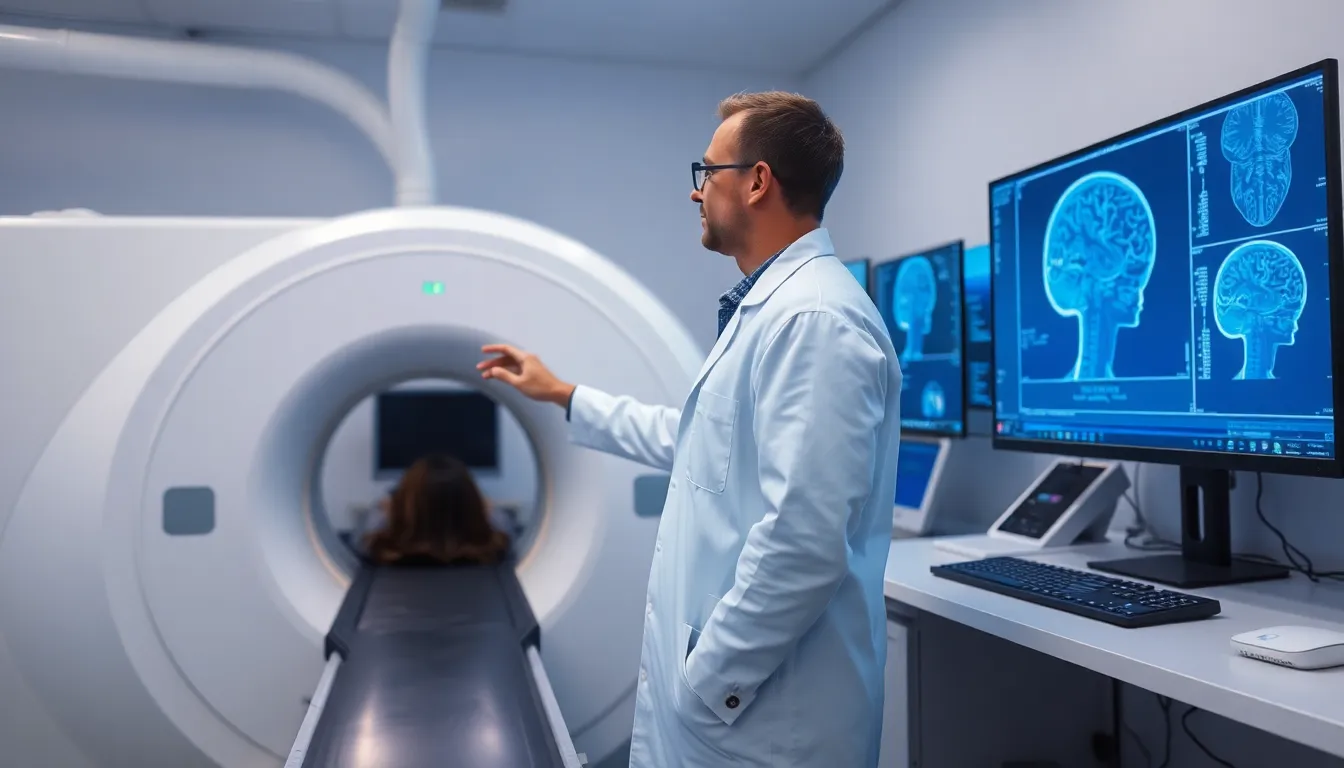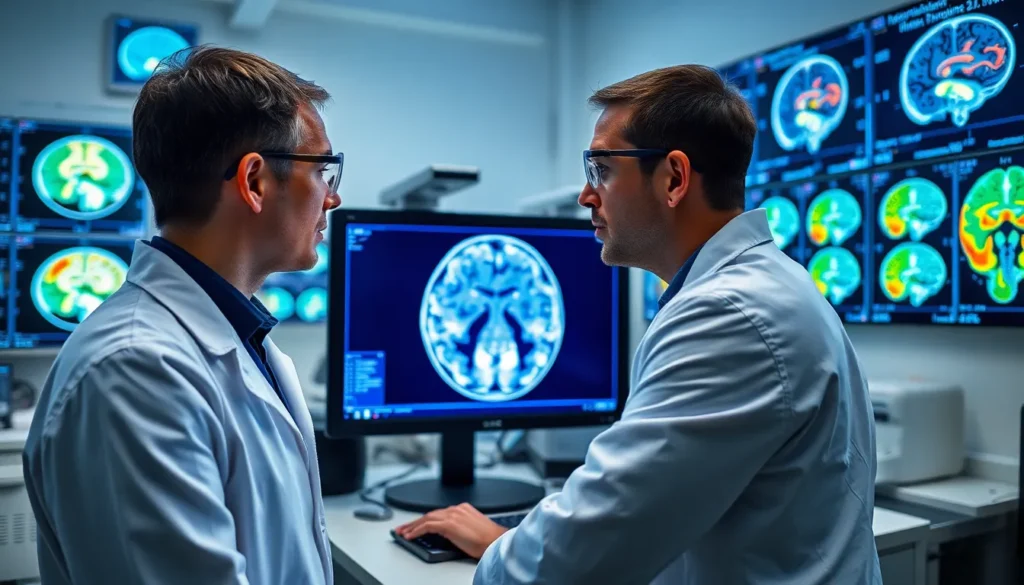Table of Contents
ToggleImagine peering into the most complex, intricate network in the universe—your brain. Brain mapping is like a treasure map for understanding how this magnificent organ works. Scientists are diving deep into its folds and crevices, uncovering secrets that could change the way we treat everything from mental health issues to neurological disorders.
Overview of Brain Mapping
Brain mapping refers to techniques and methods used to create comprehensive representations of brain structures and functions. This field has evolved significantly, with several imaging technologies contributing to a deeper understanding of the brain’s organization. Functional magnetic resonance imaging (fMRI) and positron emission tomography (PET) are prominent tools in this area. These technologies enable scientists to visualize brain activity and identify regions associated with specific cognitive tasks.
Research indicates that brain mapping can lead to significant advancements in treatments for mental health conditions and neurological disorders. Studies show that mapping the brain allows for targeted therapies, enhancing the effectiveness of interventions. Neurosurgeons utilize brain mapping during surgical procedures to minimize risks and preserve vital functions. Furthermore, identifying specific neural pathways fosters the development of personalized medicine approaches.
Collaboration among researchers is crucial in advancing brain mapping techniques. Interdisciplinary efforts combine neuroscience, engineering, and computational modeling to refine data analysis methods. Such collaboration enhances the accuracy and efficiency of brain maps. Data obtained from this research helps to investigate disorders like Alzheimer’s disease, epilepsy, and schizophrenia.
Brain mapping continuously evolves, driven by technological innovations and collaborative efforts. As understanding of the brain’s complexities expands, potential applications may include developing better diagnostic tools and treatment plans. This progress signifies a move toward improved healthcare solutions for various neurological conditions.
Techniques Used in Brain Mapping

Brain mapping employs various techniques to gain insights into brain structure and function. Two prominent methods include functional MRI and electrophysiology, each contributing uniquely to the field.
Functional MRI
Functional MRI (fMRI) measures brain activity by detecting changes in blood flow. It identifies areas that become active during cognitive tasks, providing a real-time view of brain function. Researchers utilize fMRI for various applications, including understanding the neural basis of memory and emotion. For instance, studies often reveal how different brain regions coordinate during problem-solving. With its non-invasive nature, fMRI stands as a crucial tool in both research and clinical settings, helping to tailor individualized treatment plans.
Electrophysiology
Electrophysiology records electrical activity across neurons using methods like EEG and invasive electrodes. It allows for high temporal resolution, capturing rapid brain signaling in milliseconds. This technique helps dissect the timing of neural events linked to sensory processing and motor control. With applications in clinical diagnostics, electrophysiology plays a key role in monitoring conditions such as epilepsy. Researchers increasingly leverage electrophysiological data to enhance understanding of brain communication and develop targeted interventions.
Applications of Brain Mapping
Brain mapping has numerous applications across various fields, significantly impacting clinical practice and research.
Clinical Applications
Clinicians rely on brain mapping techniques to enhance patient care. Surgeons utilize these methods during procedures to locate critical areas, minimizing risk and preserving neurological functions. Personalized treatment plans emerge from brain mapping data, facilitating tailored interventions for mental health disorders and neurological issues. Schizophrenia, epilepsy, and depression treatments benefit from targeted therapies driven by brain activity insights. Moreover, brain mapping aids in identifying biomarkers for Alzheimer’s disease, improving diagnostic accuracy and early intervention strategies.
Research Applications
Scientists employ brain mapping for understanding complex brain functions. Research teams use functional MRI to explore neural pathways linked to behavior, memory, and emotion. Investigations into cognitive processes uncover significant patterns in brain activity that inform both theoretical knowledge and practical outcomes. Researchers also rely on electrophysiological techniques to analyze rapid signaling across neurons, advancing comprehension of brain interactions. Collaborative efforts across disciplines, including psychology and neurology, enhance data interpretation, pushing the boundaries of knowledge regarding brain disorders and paving the way for innovative treatments.
Challenges and Limitations
Brain mapping faces several challenges that hinder its full potential. One significant limitation involves the complexity of individual brain structures. Each person’s brain is unique, impacting the consistency of mapping results across different populations. Variability in brain anatomy makes standardization difficult.
Technological constraints also pose challenges. While functional MRI and electrophysiology provide valuable insights, these techniques can be expensive and resource-intensive. Accessibility to high-quality imaging equipment limits widespread usage in clinical settings.
Data interpretation presents another hurdle. Analyzing vast amounts of brain data requires specialized knowledge and sophisticated algorithms. Misinterpretations can lead to inaccurate conclusions, affecting research outcomes.
Ethical concerns arise within the realm of brain mapping. Privacy issues related to sensitive brain data necessitate strict guidelines. Researchers and clinicians must navigate these ethical considerations to maintain integrity and protect patients’ rights.
Neuroscientific limitations hinder understanding of complex interactions within the brain. Current methods often focus on isolated regions rather than examining system-wide connectivity. This narrow approach may overlook important relationships necessary for comprehensive mental health treatments.
Lastly, advancements in brain mapping often require interdisciplinary collaboration. Coordination among neuroscientists, psychologists, and engineers is essential to drive innovation. However, limited communication across disciplines can slow progress and further complicate the research landscape.
Addressing these challenges is crucial for the advancement of brain mapping techniques. Improvements in technology, analysis, and collaboration will foster breakthroughs in understanding and treating neurological disorders.
Future Directions in Brain Mapping
Innovations in brain mapping technologies promise exciting advancements in neuroscience. Enhanced imaging methods that increase resolution offer opportunities to explore the brain’s complex network further. Researchers are developing portable devices that can facilitate brain monitoring outside clinical settings, expanding accessibility for continuous data collection.
Artificial intelligence is playing a pivotal role in advancing data analysis, with machine learning algorithms capable of identifying patterns in vast brain datasets. These patterns can reveal distinct neural pathways related to various mental health conditions. Collaborative initiatives among institutions aim to create comprehensive brain atlases, providing standardized frameworks that enhance the comparison of findings across studies.
Translational research is focusing on the application of brain mapping findings into clinical practices. Therapies based on individual brain maps can lead to personalized interventions, tailoring treatments for conditions such as depression and anxiety. This personalized approach enhances the chances of treatment effectiveness while reducing trial and error in medication selection.
Ethical frameworks are evolving alongside technology, prioritizing patient rights and data privacy. Researchers are establishing protocols to ensure sensitive information is handled appropriately. Building public trust fosters greater participation in research initiatives, crucial for obtaining diverse data that reflect different brain structures and functions.
Moreover, integration of brain mapping with neurotherapeutics aims to revolutionize treatment modalities. Techniques such as transcranial magnetic stimulation and deep brain stimulation are becoming more nuanced, informed by precise mapping of brain areas. As the understanding of brain connectivity matures, future therapies may target not just individual regions but also the intricate networks connecting them.
Adapting brain mapping methods to study neurodevelopmental disorders presents a critical frontier. Early identification of abnormalities in brain function during development can lead to timely interventions. Embracing multidisciplinary collaboration among neuroscientists, clinicians, and ethicists will drive innovations, enhancing the quality of life for individuals affected by brain disorders.
Brain mapping stands at the forefront of neuroscience, offering transformative insights into the brain’s complex functions. As researchers continue to innovate and refine mapping techniques, the potential for personalized treatments grows, promising better outcomes for those facing mental health and neurological challenges. The integration of advanced technologies and interdisciplinary collaboration will be key in overcoming existing limitations.
Future advancements in brain mapping could revolutionize how conditions are diagnosed and treated, paving the way for a deeper understanding of brain disorders. By prioritizing ethical considerations and patient rights, the field can foster public trust and enhance participation in research. Ultimately, the ongoing exploration of brain mapping holds the promise of improving the quality of life for countless individuals.







